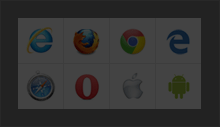|
Adobe, Microsoft Spar Over Flash, Silverlight, HTML5
Author: its
|
Post: 11/12/2013 (4:04 PM)
|
Reads: 2296
|
Comments: 0
|
Static Url
|
Content html code
Almost three years ago, Microsoft came out with Silverlight 1.0. While Adobe may have been sanguine at the time, Microsoft has pushed Silverlight relentlessly, successfully, and with almost nary a mark on Adobe's hegemony, indicating perhaps that there was always room for both. Now, on the metaphorical eve of HTML5, we got Adobe and Microsoft to come debate us and each other, and to talk about the next battlefield: Mobile.
I will frame the debate and a few highlights below, but you can download the audio of The Fritz & David Show, or click the little play button in this sentence. The podcast player should appear as a pull-out tab near the lower left hand side of your browser's window. The Podcast includes, as always, Techweb's Chief Content officer, David Berlind and me, but also Dr. Dobbs Editor-in-Chief Jon Erickson, Microsoft's Director of Developer Platform Marketing, Brian Goldfarb and Adobe's Director of Technology Strategy, Anup Murarka.
I'd like to personally thank both Goldfarb and Murarka, along with the PR folks representing Microsoft and Adobe-- getting on a podcast together, going toe-to-toe is always a risky proposition-- and both companies were immediately game to do it. David and I found that particularly refreshing.
Attracting Developers
Developer mindshare is ultimately what Microsoft and Adobe are battling for. Adobe rides a history that gives Flash almost complete end-user market share: 98 percent of Internet-connected desktops run Flash, Adobe claims, and 95 percent were running Flash 10 within a year of its availability. This is clearly important to developers. Since Adobe isn't in the OS platform business, it has made significant investment in running within every browser and on every platform.
Microsoft, now on Silverlight v4, claims 45 percent penetration, and higher (60 percent) in Europe and Asia. It also runs across platforms and browsers, although it has taken some heat on its slothful support of Linux. It supports Novell Moonlight (any user of any Linux distribution can go to Novell and get Moonlight which will run on any Linux distribution; for free).
Just as important, Microsoft claims a developer community of half a million.
Both have marquee customers. Microsoft will certainly benefit from the current spate of high-profile live sporting events, including the just-concluded Winter Olympics, the imminent onslaught of March Madness (college basketball's annual year-end championship tournament). It also runs the Netflix Watch Instantly service and, my personal favorite, Victoria's Secret Fashion Show. Adobe simply powers most of the biggest web video sites in the world, including YouTube and Hulu (numbers one and two in terms of online video traffic).
We debated these numbers, and what they mean (and how to interpret them), but there's another factor we spent significant time sparring over: the quality and access to developer tools. One of the smartest things Microsoft did when it released Silverlight is to make it instantly accessible to the Windows development community. Microsoft .NET developers could create Silverlight applications (using Visual Studio). Flash uses Actionscript, and Adobe has its own set of tools for building Flash applications (Flex, Flash Builder, and enterprise applications using Eclipse).
| 









